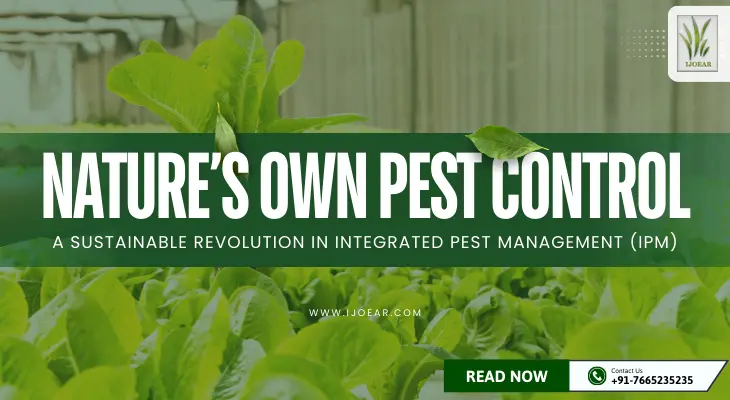
The agricultural world is witnessing a quiet but powerful revolution. Instead of relying solely on chemical pesticides, farmers are increasingly turning to nature itself for solutions. One of the most promising innovations is the use of yeast- and sugar-based sprays to attract natural predators—such as ladybirds and lacewings—to control pests in a safe, sustainable way. This method is part of Integrated Pest Management (IPM) and is already making a difference in countries like India, Ethiopia, Kenya, and beyond.
Integrated Pest Management is a science-based, ecosystem-friendly approach to controlling agricultural pests. Rather than eradicating pests completely—which can disrupt ecological balance—IPM focuses on managing them at tolerable levels using a mix of biological, cultural, and mechanical techniques.
This modern approach aims to:
The innovation lies in using natural attractants instead of synthetic chemicals.
This approach is safe for pollinators like bees and butterflies, unlike many chemical pesticides that can cause unintended harm.
Unlike chemical pesticides, this method leaves no toxic residues on crops, in the soil, or in water bodies. This means food is safer for consumers, and ecosystems remain healthy, protecting pollinators like bees from harmful exposure.
Synthetic pesticides can be expensive and require frequent application. By switching to yeast- and sugar-based sprays, farmers reduce input costs, making agriculture more financially sustainable, especially for smallholder farmers.
This approach promotes a balanced ecosystem. By drawing in natural predators, farmers avoid harming non-target species, maintaining a diverse and healthy insect population. This biodiversity strengthens the resilience of farmland against pest outbreaks.
Chemical pesticides often lead to pest resistance, making them less effective over time. With yeast- and sugar-based sprays, the risk of pests developing resistance is significantly lower, ensuring long-term effectiveness.
This natural pest control method works effectively even in variable weather conditions—a crucial advantage in the face of climate change, where unpredictable rainfall and temperature swings can render some chemical solutions less reliable.
While yeast- and sugar-based pest control offers tremendous promise, its adoption still faces certain hurdles:
Many farmers are unfamiliar with the optimal timing and concentrations needed for best results. Agricultural extension services and farmer training programs are essential to ensure correct application.
Current application methods are more suited for small to medium farms. Developing mechanized spraying systems for large-scale operations is still in progress, and once available, could greatly increase adoption.
Different pests dominate in different climates. Ongoing research aims to tailor attractants for specific pest species and regional conditions, making the method more universally applicable.
Looking ahead, scientists are working on commercially packaged formulations of these natural attractants, making them easier to store and use. This could help scale adoption worldwide and further reduce dependency on harmful chemicals.
The rise of yeast- and sugar-based sprays in Integrated Pest Management is a shining example of how innovation and ecology can work hand-in-hand. By inviting nature’s own pest controllers into the fields, farmers are protecting their crops, preserving biodiversity, and safeguarding the planet for future generations. From small farms in India to coffee estates in Ethiopia, this sustainable method is proving that sometimes, the sweetest solutions are also the smartest.
Integrated Pest Management (IPM) is a sustainable approach to controlling pests by combining biological, cultural, mechanical, and chemical methods in a way that minimizes harm to people, beneficial organisms, and the environment. It focuses on prevention and long-term pest control rather than just eradication.
“Nature’s own pest control” refers to using beneficial insects, natural predators, and microorganisms to control harmful pests. Examples include ladybugs eating aphids, nematodes targeting soil-dwelling larvae, or fungi that attack crop-damaging insects. This reduces reliance on synthetic pesticides.
IPM is sustainable because it:
Common examples include:
Not always. While IPM significantly reduces chemical use, pesticides may still be used as a last resort when pest populations exceed economic thresholds. The goal is to apply them in targeted, minimal, and environmentally friendly ways.
Yes. IPM can be adapted to any scale of farming, from backyard gardens to industrial farms. The strategies vary depending on crop type, climate, and pest pressure.
Farmers use techniques such as:
Initially, IPM may require more labor for monitoring and planning. However, in the long term, it often reduces costs by lowering pesticide expenses, preserving beneficial insects, and improving crop health.
Yes. By combining different control methods and reducing reliance on a single pesticide, IPM slows down the development of pesticide-resistant pest populations.
Farmers need to:
 NAAS Rating: 4.23
NAAS Rating: 4.23  October 2025 Issue
October 2025 Issue  Impact Factor: 6.69
Impact Factor: 6.69  Submit Article
Submit Article 
|
Citation Indices
|
All
|
Since 2020
|
|
Citation
|
6164
|
5117
|
|
h-index
|
31
|
29
|
|
i10-index
|
201
|
165
|
|
Acceptance Rate (By Year)
|
|
|
Year
|
Percentage
|
|
2024
|
11.09%
|
|
2023
|
15.23%
|
|
2022
|
12.81%
|
|
2021
|
10.45%
|
|
2020
|
9.6%
|
|
2019
|
14.3%
|
|
2018
|
17.65%
|
|
2017
|
16.9%
|
|
2016
|
22.9%
|
|
2015
|
26.1%
|